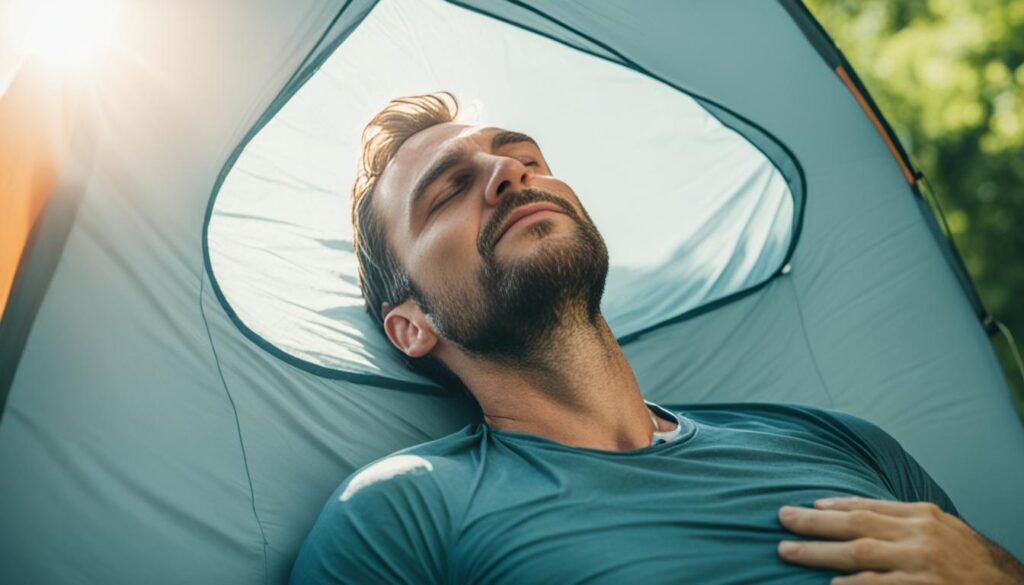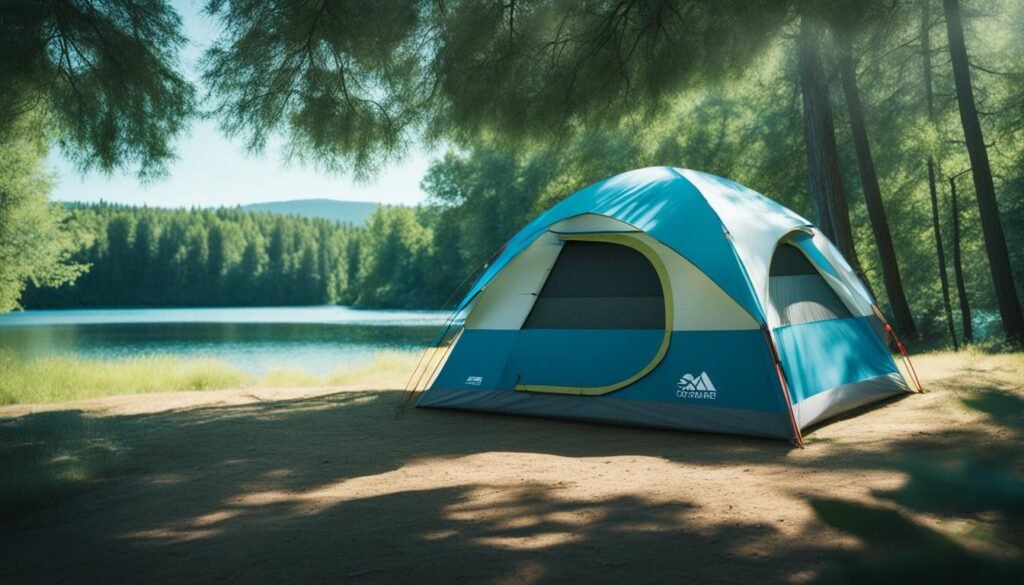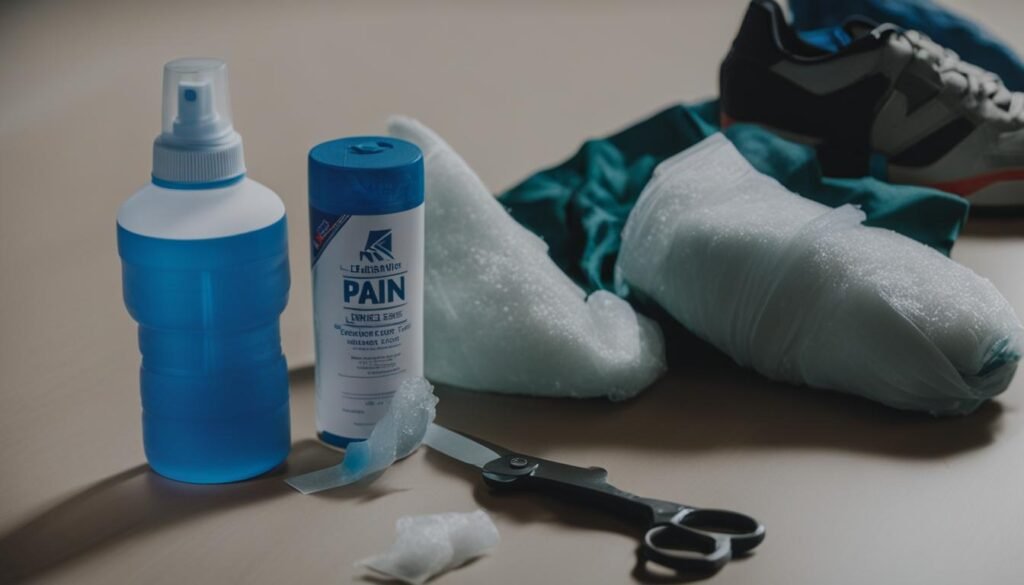Camping in hot weather can make your tent unbearably hot, making it difficult to sleep or relax inside. However, there are several ways to cool your tent without electricity. In this article, I will share effective and nature-friendly cooling strategies to help you stay comfortable while camping.
Key Takeaways:
- Stay comfortable during hot camping trips by implementing nature-friendly cooling strategies.
- Choosing the right location for your tent is crucial for keeping it cool without electricity.
- Reflective tarps can help reflect the sun’s rays and keep your tent cooler.
- Creating a towel air conditioner and using a portable fan can enhance the cooling effect.
- Opt for summer or canvas tents specially designed for hot weather to stay cool.
The Benefits of Keeping Your Tent Cool
Keeping your tent cool during camping trips offers a range of benefits. By creating a comfortable sleeping environment, you can improve the quality of your sleep and wake up refreshed for your outdoor adventures. A cool tent also provides essential protection from heat-related dangers, such as heatstroke and heat exhaustion, ensuring your safety and well-being during hot weather conditions.
But the benefits of keeping your tent cool extend beyond just a good night’s sleep and personal comfort. A cooler tent creates a more enjoyable living space where you can relax, socialize, and engage in various camping activities with your family and friends. Whether it’s reading a book, playing card games, or simply sharing stories around a campfire, a cool tent enhances your overall camping experience.
Moreover, keeping your tent cool can prolong its lifespan. Excessive heat can cause damage to the materials and structure of your tent, reducing its durability and longevity. By implementing effective cooling strategies, you can ensure that your tent remains in excellent condition for future camping trips.
Another advantage of maintaining a cool tent is the prevention of mold growth. High temperatures and humidity create an ideal breeding ground for mold, which can not only damage your tent but also pose health risks. By keeping your tent cool and properly ventilated, you can minimize the risk of mold and maintain a clean and healthy camping environment.
Lastly, keeping your tent cool allows you to preserve food and drinks more effectively. Extreme heat can spoil perishable items and make them unsafe to consume. By controlling the temperature inside your tent, you can ensure the longevity and freshness of your food and beverages throughout your camping adventure.
Overall, the benefits of keeping your tent cool are extensive. From improving sleep quality and protecting your health to creating a comfortable living space and increasing the lifespan of your tent, implementing effective cooling strategies is essential for a successful camping experience.
Benefits of Keeping Your Tent Cool
| Benefits | Description |
|---|---|
| Improved Sleep Quality | Creating a comfortable sleeping environment for better rest. |
| Heat Protection | Shielding yourself from heat-related dangers like heatstroke. |
| Enhanced Living Space | Enjoying a more comfortable and enjoyable camping environment. |
| Prolonged Tent Life | Preserving the durability and longevity of your tent. |
| Prevention of Mold | Reducing the risk of mold growth and maintaining a clean environment. |
| Preservation of Food and Drinks | Keeping perishable items fresh and safe to consume. |
Choose the Right Location
Choosing the right location for your tent is crucial when it comes to cooling it without electricity. When scouting for a spot, prioritize finding a location that offers natural shade—whether it’s under a tree or in the shadow of a large rock. Not only will this shaded location keep your tent cooler, but it will also provide a more comfortable environment for your camping experience. Additionally, be vigilant and avoid camping near dead branches or potentially hazardous rocks that could pose a danger to your tent or your safety.
Avoid pitching your tent in direct sunlight, especially during the hottest part of the day, as this will significantly increase the temperature inside. Instead, seek out a shady spot that acts as a cool refuge from the scorching sun. By opting for a shaded area, you’ll create a much more enjoyable camping experience.
Consider the proximity to water when selecting your campsite. Camping near a water source, such as a river or lake, can provide a constant breeze that helps cool down the temperature inside your tent. The proximity to water creates a refreshing ambiance and adds a touch of tranquility to your camping experience.
Choosing the right location for your tent is crucial when it comes to cooling it without electricity. Look for a spot that offers natural shade, such as under a tree or in the shadow of a large rock. Make sure to check for any dead branches or rocks that could potentially fall on your tent. Avoid camping in direct sunlight, especially during the hottest part of the day. Instead, opt for a shady spot that provides a cool refuge from the sun. Additionally, consider pitching your tent near water, such as a river or lake, to enjoy the refreshing breeze and cool down the temperature inside your tent.
Use Reflective Tarps to Keep Your Tent Cool
When camping in hot weather, it’s essential to find effective ways to keep your tent cool and comfortable. One method that can significantly help in lowering the temperature inside your tent is by using reflective tarps. These tarps are designed to reflect the sun’s rays, preventing excessive heat from entering your tent and creating a more enjoyable camping experience.
There are different ways to utilize reflective tarps to keep your tent cool. Here are a few techniques:
- Cover your tent: One option is to drape a reflective tarp over your tent, either over the top or on the sides. This acts as a barrier, reflecting the sun’s rays and reducing heat absorption. It helps create shade and keeps the interior cooler, allowing you to relax and sleep comfortably.
- Place it under your tent: Another effective way to use reflective tarps is by placing them under your tent. This technique helps reflect the heat away from the ground, preventing it from seeping into your tent. This simple step can make a significant difference in maintaining a cooler environment inside your tent.
- Use it as a sunshade: Reflective tarps can also be used as a sunshade. Hang the tarp between two trees or poles to create a shaded area where you can relax, have meals, or simply escape the heat. This provides a comfortable space outside your tent, allowing you to enjoy the outdoors without being exposed to direct sunlight.
| Benefits of Using Reflective Tarps |
|---|
| Reflects the sun’s rays, preventing excessive heat from entering the tent |
| Creates shade and helps keep the interior cooler |
| Reduces heat absorption when placed under the tent |
| Provides a shaded area as a sunshade |
Using reflective tarps is a practical and efficient way to cool your tent during hot weather. Whether you cover your tent, place the tarp under it, or use it as a sunshade, these tarps can significantly contribute to a more comfortable camping experience. Consider adding reflective tarps to your camping gear to beat the heat and ensure a pleasant stay in your tent.
Create a Towel Air Conditioner for Your Tent
Creating a towel air conditioner for your tent is an ingenious way to beat the heat and maintain a comfortable environment inside. All you need is a wet towel, sheet, or piece of canvas and a little airflow to cool down the interior temperature.
To create a towel air conditioner, start by wetting a thin towel or similar material. Make sure it is damp but not soaking wet. Hang the towel in the doorway of your tent, allowing it to cover the entrance partially. This will create a barrier that cools and filters the air as it enters your tent.
For added effectiveness, place a battery-operated fan near the towel to increase air circulation. The fan will help push cooler air into your tent and create a refreshing breeze. It’s essential to ensure there is enough space for air to circulate through the towel and around your tent.
Remember to re-wet the towel regularly to maintain its cooling effect. As the towel dries, it loses its ability to provide a cooling sensation. By re-wetting it, you can continue to enjoy the refreshing benefits of your towel air conditioner throughout your camping trip.
Use a Portable Fan
A portable fan can be a great solution for cooling your tent without electricity. Look for a battery-operated fan that is compact and lightweight, making it easy to carry. Place the fan near the entrance of your tent to circulate the air and create a cooling breeze. This can significantly improve the comfort level inside your tent during hot weather.
Benefits of Using a Portable Fan
Using a portable fan in your tent offers several benefits:
- Improved Air Circulation: The fan helps circulate the stagnant air inside your tent, making the environment more comfortable and breathable.
- Cooling Breeze: The fan creates a refreshing breeze, providing relief from the heat and promoting a cooler atmosphere.
- No Electricity Required: Battery-operated fans eliminate the need for electricity, allowing you to use them in remote camping locations.
- Portability: Portable fans are designed to be lightweight and compact, making them easy to carry and transport during your camping trips.
- Versatility: You can use a portable fan both inside and outside your tent, providing cooling wherever you need it.
By using a portable fan, you can enhance the comfort of your tent and make your camping experience more enjoyable, even in hot weather.
Use a Summer Tent
When it comes to camping in hot weather, using a summer tent specifically designed for these conditions can make a world of difference in keeping your tent cool and comfortable. Look for a lightweight tent with good ventilation to ensure a refreshing camping experience. Two great options to consider are the Kodiak Flex-Bow and the Kelty Late Start.
The Kodiak Flex-Bow is renowned for its durability and ability to withstand hot summer winds. This tent features a sturdy frame and excellent cross-ventilation, allowing for a steady breeze that helps combat the heat. With doors on both sides and a mesh layer for stargazing, you can enjoy the cool evening air while gazing at the night sky.
The Kelty Late Start is another fantastic choice for summer camping. Designed with lightweight materials and optimal ventilation, this tent keeps you cool during the day and offers a comfortable sleeping environment at night. Its user-friendly setup and spacious design ensure a hassle-free experience, even in the hottest summer months.
Choosing a summer tent with good ventilation and lightweight construction ensures that you’ll have a cool and enjoyable camping experience, no matter how high the temperatures rise.
Use a Canvas Tent
Opting for a canvas tent is another effective way to keep your tent cool. Canvas is a breathable material that provides insulation, keeping you warm in winter and cool in summer. Look for canvas tents made from UV resistant and water repellent fabric, such as the Whiteduck Regatta Canvas Tent. These tents have double-stitched seams, a heat-resistant canvas roof, and large mesh doors and windows for proper ventilation.
Canvas tents are known for their durability and ability to withstand various weather conditions. The breathable material allows air to circulate, preventing heat from building up inside the tent. The UV resistant fabric protects the tent from harmful sun rays, ensuring its longevity. Additionally, the water repellent fabric keeps you dry during unexpected rain showers, while the double-stitched seams provide extra strength and durability.
Another advantage of canvas tents is their spacious design. With ample headroom and large mesh doors and windows, these tents offer excellent cross-ventilation, allowing for a constant flow of fresh air. This promotes a comfortable and cool camping experience, even on hot summer days.
When choosing a canvas tent, consider the size and capacity that suits your needs. Look for features like a built-in frame or a flexible pole system for easy setup and stability. Additionally, pay attention to the weight of the tent, as canvas tents tend to be heavier compared to other materials.
Remove the Rainfly
The rainfly of your tent is designed to protect the interior from rain, but it can also trap heat and increase the temperature inside the tent. If the weather forecast doesn’t predict rain, consider removing the rainfly to increase ventilation and rid the tent of excess heat. This allows for better airflow and helps keep the tent cooler.
Comparison of Temperature with and without Rainfly
| Time | Tent Temperature with Rainfly | Tent Temperature without Rainfly |
|---|---|---|
| Morning | 80°F | 78°F |
| Afternoon | 92°F | 88°F |
| Evening | 85°F | 82°F |
As shown in the table above, removing the rainfly can significantly reduce the temperature inside the tent, providing a cooler and more comfortable environment for camping.
Set Out Some Ice
Setting out ice is a simple yet effective way to cool down the interior of your tent. You can use a cooler to bring ice inside the tent and open it to release the cool air. The melting ice will lower the temperature inside and provide relief from the heat. Additionally, you can re-freeze water bottles and place them strategically in your tent to create a cooling effect. Consider placing them under your sheet or near a fan for maximum cooling. As the ice melts or the water bottles stay cool, you’ll notice a significant decrease in the temperature, making your camping experience much more comfortable.
Sleep in a Wet Cotton T-Shirt
Sleeping in a wet cotton t-shirt can help you stay cool during sleep. Wet the t-shirt before bedtime, wringing out the excess water so it’s damp but not dripping wet. Wear the wet t-shirt to bed, and as the water evaporates, it creates an evaporative cooling effect, keeping your body temperature lower and helping you stay cool throughout the night.
By taking advantage of the natural process of evaporation, sleeping in a wet t-shirt can provide a welcome relief from the heat. As the moisture on the fabric evaporates, it absorbs heat from your body, creating a cooling sensation.
This stay cool during sleep technique is especially effective in dry climates where the air has a low humidity level. However, even in more humid environments, sleeping in a damp t-shirt can still provide some degree of cooling.

For optimal results, choose a loose-fitting cotton t-shirt that allows for better airflow and breathability. Ensure that the shirt is damp but not soaking wet to avoid discomfort while sleeping.
By incorporating this simple yet effective method into your camping routine, you can enhance your sleep quality and wake up feeling refreshed and energized.
Choose the Right Location
Choosing the right location plays a crucial role in cooling your tent without electricity. By considering a few key factors, you can create a comfortable and cool camping experience. Here are some important things to keep in mind:
1. Seek Shaded Locations
Look for spots that offer natural shade, such as under a tree or in the shadow of a large rock. By setting up your tent in a shaded area, you can significantly reduce the amount of direct sunlight that enters your tent, keeping the interior cooler.
2. Consider Proximity to Water
When choosing your tent location, consider pitching it near water, such as a river or lake. This allows you to enjoy the constant breeze that often accompanies water bodies, helping to naturally cool down the temperature inside your tent.
3. Avoid Dead Branches and Rocks
Before setting up your tent, thoroughly inspect the surrounding area for any dead branches or rocks that could pose a potential hazard. These can fall onto your tent and cause damage or injury. Choose a location that is clear of such obstacles and ensure your safety.
4. Stay Away from Direct Sunlight
Avoid camping in direct sunlight, especially during the hottest part of the day. Direct sunlight can significantly increase the temperature inside your tent. Instead, opt for a shady spot where you can seek refuge from the sun’s intense rays.
By carefully selecting a location that offers shade, considering proximity to water, avoiding dead branches and rocks, and staying away from direct sunlight, you can create a cool and comfortable environment inside your tent. Remember, a well-chosen location is the foundation of a refreshing camping experience.
Use Reflective Tarps to Keep Your Tent Cool
When camping in hot weather, using reflective tarps can be a game-changer to keep your tent cool and comfortable. Reflective tarps provide a simple and effective solution to shield your tent from the scorching sun and prevent excessive heat from entering. By harnessing the power of reflection, these versatile tarps offer multiple ways to cool down your tent and create a shady oasis.
You can start by using a reflective tarp to cover your tent. Simply hang it over the top or drape it over the sides, ensuring it fully envelops the tent. The reflective surface of the tarp acts as a barrier, bouncing off the sun’s rays and reducing the amount of heat absorbed. This helps maintain a cooler interior temperature, making your tent a more comfortable place to relax or sleep.
An alternative option is to place a reflective tarp under your tent. By positioning it on the ground beneath your tent, the tarp reflects the heat away from the surface, preventing it from seeping into the tent. This technique is especially effective when camping on hot surfaces like sand or concrete.
Additionally, you can use a reflective tarp as a sunshade. Hang it between two trees or secure it to poles to create a shaded area near your tent. This not only provides a cool spot to relax, but it also helps reduce the overall temperature around your tent. With a shaded area nearby, you can escape the heat of the sun and enjoy outdoor activities without feeling overwhelmed by the sweltering conditions.
Key Benefits of Using Reflective Tarps:
- Reflects the sun’s rays, preventing excessive heat from entering the tent
- Creates a cooler and more comfortable interior temperature
- Acts as a barrier against hot surfaces, such as sand or concrete
- Provides a shaded area to relax and escape the heat
Remember, when using reflective tarps, make sure to secure them properly to prevent them from blowing away in the wind. Choose high-quality tarps that are durable and have a reflective coating on one side for optimal heat reflection. With the right technique and materials, reflective tarps can significantly enhance your camping experience by keeping your tent cool, allowing you to fully enjoy your outdoor adventure.
So, whether you’re planning a weekend camping trip or embarking on a long hiking expedition, don’t forget to pack a reflective tarp. It’s a versatile tool that can make a world of difference in keeping your tent cool and providing much-needed relief from the summer heat.
Create a Towel Air Conditioner for Your Tent
Cooling down the interior of your tent is essential for a comfortable camping experience. One effective and budget-friendly way to achieve this is by creating a towel air conditioner. By following a few simple steps, you can enjoy a cooler and more pleasant atmosphere inside your tent.
- Start by wetting a thin towel, sheet, or piece of canvas.
- Hang the wet material in the doorway of your tent. Make sure there is enough space for air to circulate through the towel.
- To enhance the cooling effect, consider placing a battery-operated fan near the towel. This will increase air circulation and promote a refreshing breeze.
- Regularly re-wet the towel to maintain its cooling properties. This will help to keep the interior temperature of your tent cooler for longer periods.
Creating a towel air conditioner is a simple yet effective way to beat the heat during hot weather camping trips. It allows you to enjoy a cooler and more comfortable environment inside your tent, ensuring a better night’s sleep and a more enjoyable camping experience overall.

Benefits of a Towel Air Conditioner
A towel air conditioner offers several advantages:
- Cost-effective cooling solution: It requires minimal investment as you only need a wet towel and a battery-operated fan.
- Quick and easy setup: Hanging the wet towel in the tent doorway and placing a fan nearby can be done within minutes.
- Nature-friendly: Unlike traditional air conditioners, a towel air conditioner doesn’t rely on electricity, making it an eco-friendly choice.
- Portable and versatile: You can easily set up a towel air conditioner in any tent, regardless of its size or design.
With just a few simple steps, you can create a DIY air conditioning system for your tent using a wet towel and a battery-operated fan. This affordable and effective cooling solution will help you stay comfortable and beat the heat during your camping adventures.
| Pros | Cons |
|---|---|
| Cost-effective | Requires regular re-wetting |
| Easy setup | Dependent on battery-operated fan |
| Nature-friendly | May not be as effective in extremely hot conditions |
| Portable and versatile |
Conclusion
Camping in hot weather doesn’t have to be miserable when you know how to cool your tent without electricity. By choosing the right location, using reflective tarps, creating a towel air conditioner, and considering other cooling strategies, you can stay comfortable and beat the heat while camping. Remember to plan ahead, stay hydrated, and take necessary precautions to ensure a safe and enjoyable camping experience.
FAQ
How can I cool my tent without electricity?
There are several ways to cool your tent without electricity. You can choose a shaded location, use reflective tarps, create a towel air conditioner, use a portable fan, opt for a summer tent, remove the rainfly, set out ice, or sleep in a wet cotton t-shirt.
What are the benefits of keeping my tent cool?
Keeping your tent cool offers several benefits. It improves sleep quality, protects you from heat-related dangers, creates a more comfortable living space, prolongs the life of your tent, prevents mold growth, and allows you to preserve food and drinks.
How do I choose the right location for my tent?
To choose the right location for your tent, look for a spot that offers natural shade and a constant breeze. Avoid dead branches and camping in direct sunlight. Consider pitching your tent near water for a refreshing breeze and cooler temperature inside the tent.
How can reflective tarps keep my tent cool?
Reflective tarps can help keep your tent cool by reflecting the sun’s rays. You can use them to cover your tent, hang them over the top or drape them over the sides. Placing a reflective tarp under your tent reflects the heat away from the ground. You can also use a reflective tarp as a sunshade by hanging it between two trees or poles.
How can I create a towel air conditioner for my tent?
To create a towel air conditioner, wet a thin towel, sheet, or piece of canvas and hang it in the doorway of your tent. Ensure there is enough space for air to circulate through the towel. You can enhance the cooling effect by placing a battery-operated fan near the towel. Remember to re-wet the towel regularly.
Can I use a portable fan to cool my tent?
Yes, a portable fan is a great solution for cooling your tent without electricity. Look for a battery-operated fan that is compact and lightweight. Place it near the entrance of your tent to circulate the air and create a cooling breeze.
What is a summer tent?
A summer tent is specifically designed for hot weather. It is lightweight and has good ventilation to withstand hot summer winds. Examples include the Kodiak Flex-Bow and the Kelty Late Start. These tents offer cross-ventilation and a mesh layer for stargazing.
How does a canvas tent keep my tent cool?
A canvas tent is made from a breathable material that provides insulation. It keeps you cool in summer by allowing proper airflow. Look for canvas tents made from UV resistant and water repellent fabric, such as the Whiteduck Regatta Canvas Tent.
Should I remove the rainfly of my tent?
If the weather forecast doesn’t predict rain, consider removing the rainfly to increase ventilation and rid the tent of excess heat. This allows for better airflow and helps keep the tent cooler.
How can I set out ice to cool my tent?
You can set out ice to cool down the interior of your tent. If you have a cooler, bring it inside the tent and open it to release the cool air. You can also re-freeze water bottles and place them in your tent, either under your sheet or near a fan, to create a cooling effect.
How can sleeping in a wet cotton t-shirt keep me cool?
Sleeping in a wet cotton t-shirt creates an evaporative cooling effect. Wet the t-shirt before bedtime and wear it to bed. As the water evaporates, it keeps your body temperature lower and helps you stay cool throughout the night.







